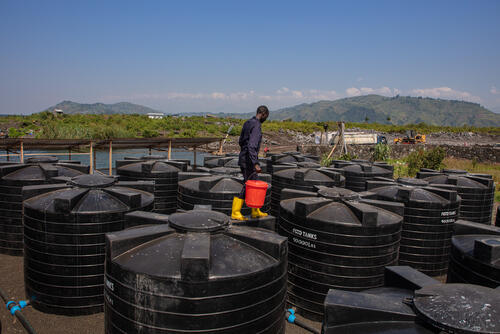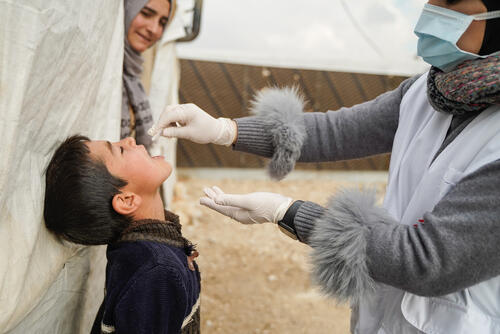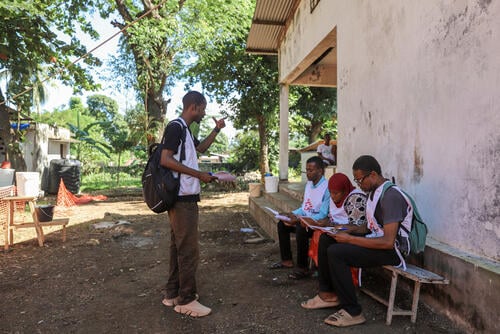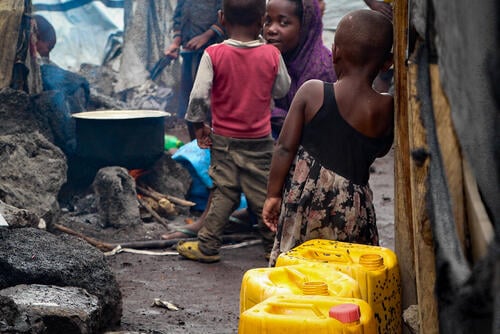Over the last two years, countries’ ministries of health and organisations like Médecins Sans Frontières (MSF) have been trying to respond to a string of cholera outbreaks around the world. Why are we seeing so many outbreaks? What’s causing them? And do we have the tools and resources needed to respond to them? MSF’s International Medical Coordinator Dr Daniela Garone explains in this interview.
What’s the current situation with cholera and how did things get so bad?
Currently, 16 countries around the world have declared an active cholera outbreak with many countries reporting larger and prolonged outbreaks. MSF teams are responding to cholera in some of these countries, including in Zambia, Zimbabwe, Ethiopia, Democratic Republic of Congo and Mozambique. Early data shows the number of cholera cases in 2023 rose by 40 per cent over 2022 and deaths increased by over 80 per cent. Over 735,000 cases were reported last year across 30 countries. Just in January this year, nearly 41,000 cases and 775 deaths have been reported.
MSF has responded to many cholera outbreaks over the last 50 years. Cholera is an extremely virulent disease transmitted through the ingestion of contaminated food or water. While the triggers for cholera outbreaks like poverty and conflict are enduring, today we face a growing threat from climate change, with increased droughts – which can force people to use unsafe sources of water – and floods, which can spread the cholera bacteria.
We also see a lack of maintenance of water, sewage and waste management infrastructure due to deteriorating economies, lingering political crises, wars or conflict, or increased movements of people, such as those who are displaced or refugees. A combination of these factors has driven cholera in the countries where we’re responding to outbreaks.
Quickly implementing sufficient oral rehydration points in multiple parts of an affected community – ensuring wide access to them – and scaling them up as needed, is crucial.Dr Daniela Garone, International Medical Coordinator
How can we respond to cholera? What tools do we have?
First, it’s important to highlight that cholera is a preventable disease. Good access to clean water, and proper sanitation infrastructure and hygiene measures reduces the likelihood of cholera outbreaks. An oral cholera vaccine can also be used to prevent and respond to outbreaks.
Unfortunately, for the last two years, the demand for oral cholera vaccines has exceeded up to four times the global production capacity. Limited manufacturing capacity has meant that only so many doses are being made. And with the extraordinary number of outbreaks around the world, the increased demand for the vaccine has far outstripped supply.
There have been measures put in place to try to maximize the limited availability of vaccines. In October 2022, the International Coordinating Group (ICG) on Vaccine ProvisionThe ICG is composed of members of the International Federation of Red Cross and Red Crescent Societies, Médecins Sans Frontières, UNICEF and WHO. – of which MSF is a member – made a last-resort decision to temporarily reduce the number of cholera vaccine doses given to people from the recommended two doses to one, to stretch out supplies. With two doses, immunity against infection lasts for three years. A single dose will provide some protection, and that’s why we are using this approach, but it is unclear how long immunity will last.

What’s the situation with the oral cholera vaccine today?
Unfortunately, nearly 18 months on since the ICG suspended the two-dose strategy for outbreak control, the situation has worsened. Today, only one manufacturer makes the pre-qualified version of the vaccineVaccines used by groups such as MSF and WHO need to be pre-qualified by WHO, having had international standards applied to their safety and efficacy, vouching for their high quality. and is producing at their maximum current capacity, after another manufacturer left the market at the end of 2022.
Even the one-dose strategy has not been enough. In 2023, 76 million doses were requested by 14 countries to implement a one-dose strategy, but only 38 million doses were available. If a two-dose strategy had been implemented, the gap in the number of vaccines would be as high as 104 million doses. And this is for outbreak response; it’s not even counting the doses needed for preventive campaigns.
Doses are being manufactured each month – but all the doses in production until mid-March have already been allocated, so the stockpile is currently empty. And unfortunately, there is no short-term solution to increase vaccine production.
Good access to clean water, and proper sanitation infrastructure and hygiene measures reduces the likelihood of cholera outbreaks.Dr Daniela Garone, International Medical Coordinator
Are there any solutions to the vaccine shortage?
The current shortage of vaccines is due to an unexpected and significant increase in the number of outbreaks with more demand for vaccines; one of the two manufacturers that supply the vaccine stockpile leaving the market in 2022, with no new manufacturers entering the market this year; and inaccuracies in supply and demand forecasting, partly related to the unpredictability of outbreaks.
Although one manufacturer is expected to enter the market towards the end of 2024 or the beginning of 2025, cholera remains a disease of the poor, is dependent on donor funds and is not a commercially attractive market. There are not enough incentives for vaccine manufacturers to enter this market. In the mid-term, we need more manufacturers to jump in and urgently produce oral cholera vaccines.
Some manufacturers who make vaccines that aren’t WHO pre-qualified could get their vaccines pre-qualified, and WHO should consider priority review of these sooner. It’s also essential that more technical support be provided for new manufacturers, to speed up regulatory processes and scale up production capacity.

With a limited number of vaccines, what else can countries and MSF teams do?
Cholera is preventable and treatable. While vaccines are a critical tool, they are not the only tool we have. There needs to be good access to clean water and sanitation infrastructure such as toilets and waste disposal. They need to be adequate to the size of the community and protected from contamination. Engaging people in communities on hygiene measures, using soap, waste management, how to avoid contamination of water sources, putting communities in charge of maintaining water points – all of this contributes to more effective outbreak control.
Access to timely testing and laboratory confirmation of cholera is not broadly available in many settings, and this delay in declaring an outbreak can affect an appropriate and timely response. Diagnosis has been happening late in many areas; and cholera is very contagious, so by the time there’s a diagnosis, the bacteria have already been spreading. There needs to be more efforts in wider, and earlier, diagnosis at the first signs of cholera symptoms.
Although cholera can kill within hours if left untreated, treatment is simple, and nobody should die of cholera in 2024. Treatment requires rehydration, including simple oral rehydration, and a course of antibiotics for people with more severe cases. But the hard reality is that many people don’t have timely access to those. Quickly implementing sufficient oral rehydration points in multiple parts of an affected community – ensuring wide access to them – and scaling them up as needed, is crucial. MSF has been responding to cholera outbreaks for the best part of 50 years – we know this saves lives very quickly. Setting up a cholera treatment centre – whether it’s in an existing structure or in tents – is possible within 24 hours.
So, in summary, in addition to vaccination, our focus to prevent and respond to cholera outbreaks must first be on access to clean water and sanitation, improved disease surveillance, better communication and engagement with communities, and improved access to healthcare for those who are sick.






